Sustainable Growth Strategies for Unilever: Challenges and Solutions
VerifiedAdded on 2023/06/09
|12
|3417
|214
Report
AI Summary
This report examines Unilever's strategies for sustainable growth, focusing on the challenges the company faces in today's business environment. It discusses the organizational life cycle and Unilever's current state, emphasizing leadership, autonomy, control, and strategic approaches like generic and intensive strategies. The report highlights the importance of a sustainable business model, detailing Unilever's efforts to balance profitability with environmental and social responsibility. Recommendations are provided to strengthen Unilever's sustainable living plan, including growing brands through innovation, reducing risks and costs, and enhancing corporate social responsibility. The analysis underscores Unilever's commitment to continuous product innovation and market penetration as key drivers for achieving long-term financial and environmental sustainability.
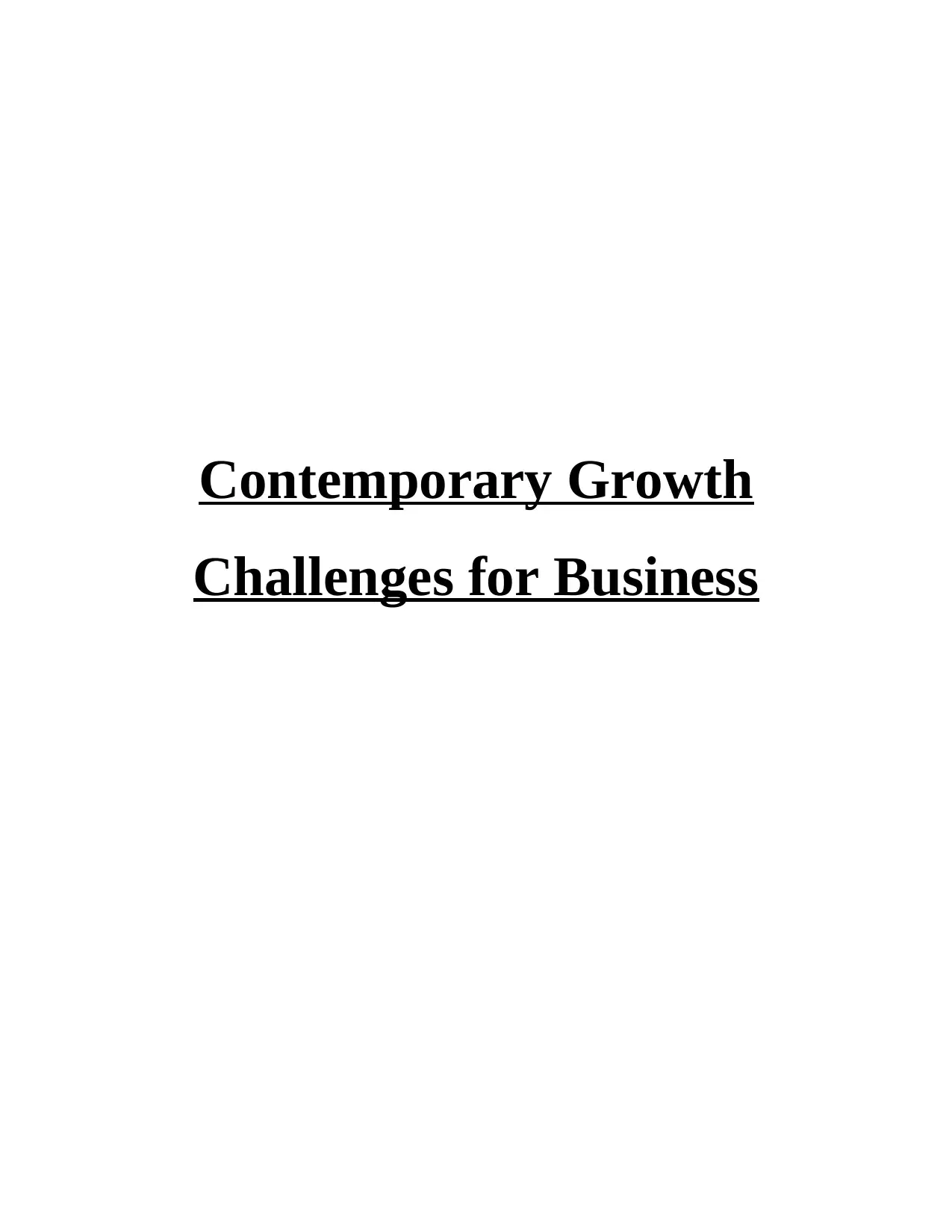
Contemporary Growth
Challenges for Business
Challenges for Business
Paraphrase This Document
Need a fresh take? Get an instant paraphrase of this document with our AI Paraphraser
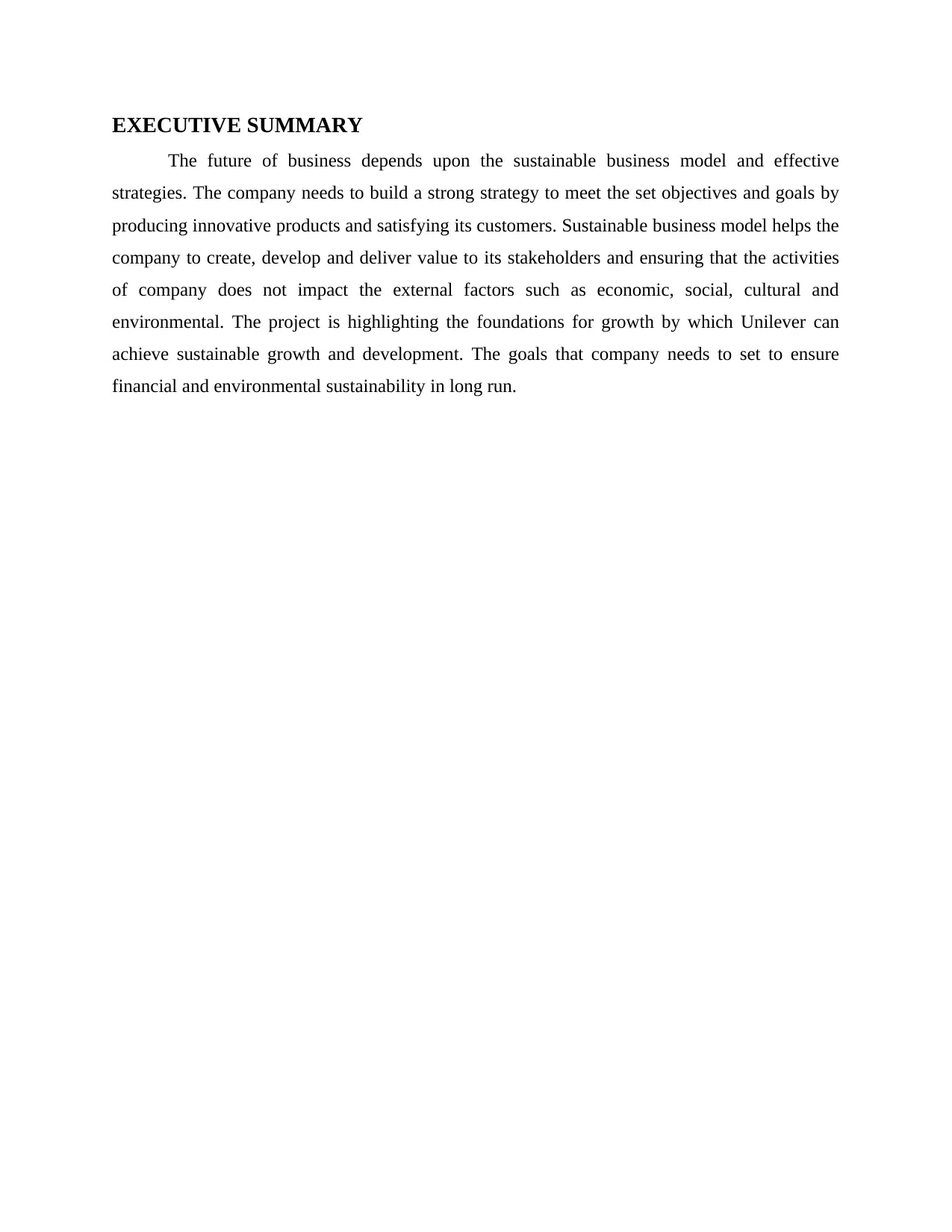
EXECUTIVE SUMMARY
The future of business depends upon the sustainable business model and effective
strategies. The company needs to build a strong strategy to meet the set objectives and goals by
producing innovative products and satisfying its customers. Sustainable business model helps the
company to create, develop and deliver value to its stakeholders and ensuring that the activities
of company does not impact the external factors such as economic, social, cultural and
environmental. The project is highlighting the foundations for growth by which Unilever can
achieve sustainable growth and development. The goals that company needs to set to ensure
financial and environmental sustainability in long run.
The future of business depends upon the sustainable business model and effective
strategies. The company needs to build a strong strategy to meet the set objectives and goals by
producing innovative products and satisfying its customers. Sustainable business model helps the
company to create, develop and deliver value to its stakeholders and ensuring that the activities
of company does not impact the external factors such as economic, social, cultural and
environmental. The project is highlighting the foundations for growth by which Unilever can
achieve sustainable growth and development. The goals that company needs to set to ensure
financial and environmental sustainability in long run.
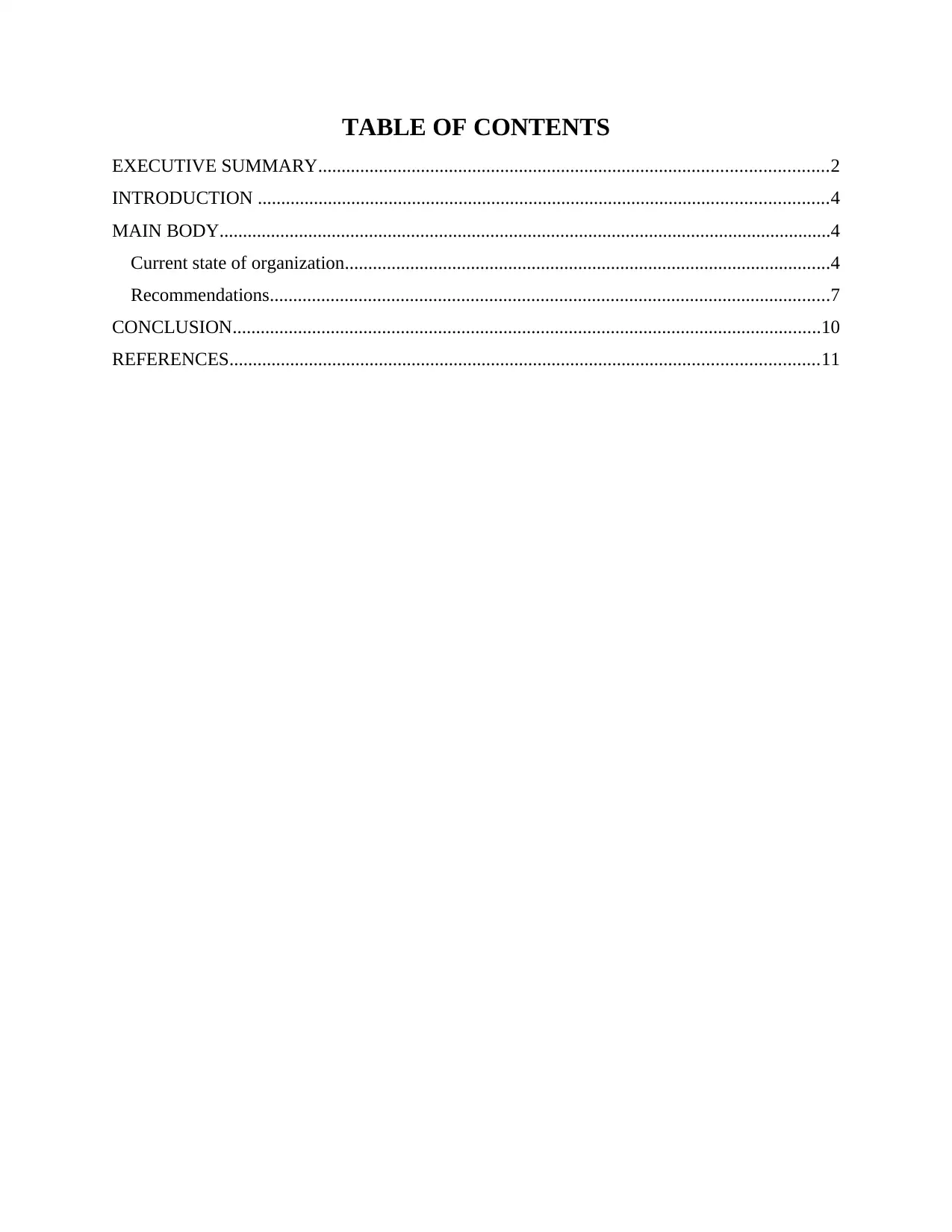
TABLE OF CONTENTS
EXECUTIVE SUMMARY.............................................................................................................2
INTRODUCTION ..........................................................................................................................4
MAIN BODY...................................................................................................................................4
Current state of organization........................................................................................................4
Recommendations........................................................................................................................7
CONCLUSION..............................................................................................................................10
REFERENCES..............................................................................................................................11
EXECUTIVE SUMMARY.............................................................................................................2
INTRODUCTION ..........................................................................................................................4
MAIN BODY...................................................................................................................................4
Current state of organization........................................................................................................4
Recommendations........................................................................................................................7
CONCLUSION..............................................................................................................................10
REFERENCES..............................................................................................................................11
⊘ This is a preview!⊘
Do you want full access?
Subscribe today to unlock all pages.

Trusted by 1+ million students worldwide
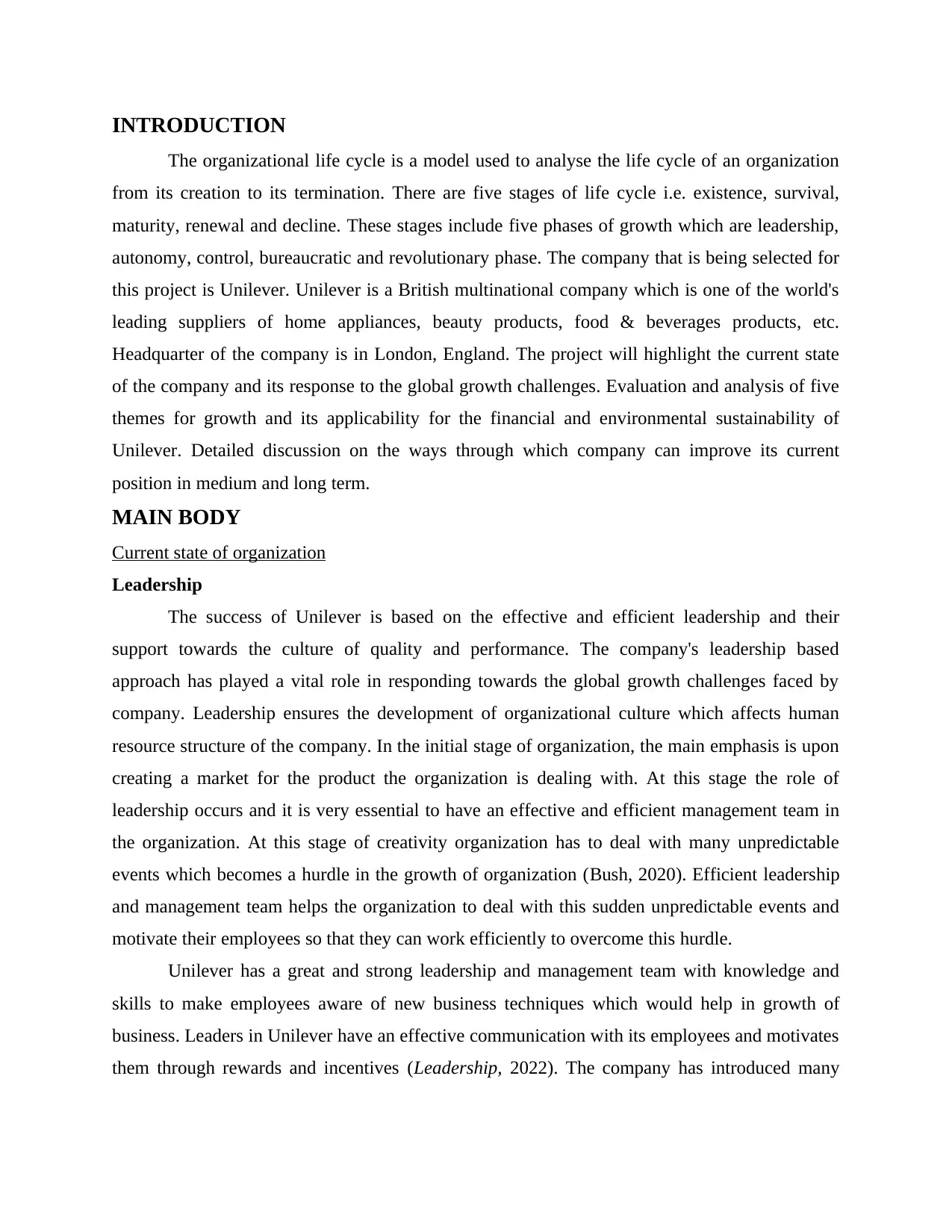
INTRODUCTION
The organizational life cycle is a model used to analyse the life cycle of an organization
from its creation to its termination. There are five stages of life cycle i.e. existence, survival,
maturity, renewal and decline. These stages include five phases of growth which are leadership,
autonomy, control, bureaucratic and revolutionary phase. The company that is being selected for
this project is Unilever. Unilever is a British multinational company which is one of the world's
leading suppliers of home appliances, beauty products, food & beverages products, etc.
Headquarter of the company is in London, England. The project will highlight the current state
of the company and its response to the global growth challenges. Evaluation and analysis of five
themes for growth and its applicability for the financial and environmental sustainability of
Unilever. Detailed discussion on the ways through which company can improve its current
position in medium and long term.
MAIN BODY
Current state of organization
Leadership
The success of Unilever is based on the effective and efficient leadership and their
support towards the culture of quality and performance. The company's leadership based
approach has played a vital role in responding towards the global growth challenges faced by
company. Leadership ensures the development of organizational culture which affects human
resource structure of the company. In the initial stage of organization, the main emphasis is upon
creating a market for the product the organization is dealing with. At this stage the role of
leadership occurs and it is very essential to have an effective and efficient management team in
the organization. At this stage of creativity organization has to deal with many unpredictable
events which becomes a hurdle in the growth of organization (Bush, 2020). Efficient leadership
and management team helps the organization to deal with this sudden unpredictable events and
motivate their employees so that they can work efficiently to overcome this hurdle.
Unilever has a great and strong leadership and management team with knowledge and
skills to make employees aware of new business techniques which would help in growth of
business. Leaders in Unilever have an effective communication with its employees and motivates
them through rewards and incentives (Leadership, 2022). The company has introduced many
The organizational life cycle is a model used to analyse the life cycle of an organization
from its creation to its termination. There are five stages of life cycle i.e. existence, survival,
maturity, renewal and decline. These stages include five phases of growth which are leadership,
autonomy, control, bureaucratic and revolutionary phase. The company that is being selected for
this project is Unilever. Unilever is a British multinational company which is one of the world's
leading suppliers of home appliances, beauty products, food & beverages products, etc.
Headquarter of the company is in London, England. The project will highlight the current state
of the company and its response to the global growth challenges. Evaluation and analysis of five
themes for growth and its applicability for the financial and environmental sustainability of
Unilever. Detailed discussion on the ways through which company can improve its current
position in medium and long term.
MAIN BODY
Current state of organization
Leadership
The success of Unilever is based on the effective and efficient leadership and their
support towards the culture of quality and performance. The company's leadership based
approach has played a vital role in responding towards the global growth challenges faced by
company. Leadership ensures the development of organizational culture which affects human
resource structure of the company. In the initial stage of organization, the main emphasis is upon
creating a market for the product the organization is dealing with. At this stage the role of
leadership occurs and it is very essential to have an effective and efficient management team in
the organization. At this stage of creativity organization has to deal with many unpredictable
events which becomes a hurdle in the growth of organization (Bush, 2020). Efficient leadership
and management team helps the organization to deal with this sudden unpredictable events and
motivate their employees so that they can work efficiently to overcome this hurdle.
Unilever has a great and strong leadership and management team with knowledge and
skills to make employees aware of new business techniques which would help in growth of
business. Leaders in Unilever have an effective communication with its employees and motivates
them through rewards and incentives (Leadership, 2022). The company has introduced many
Paraphrase This Document
Need a fresh take? Get an instant paraphrase of this document with our AI Paraphraser
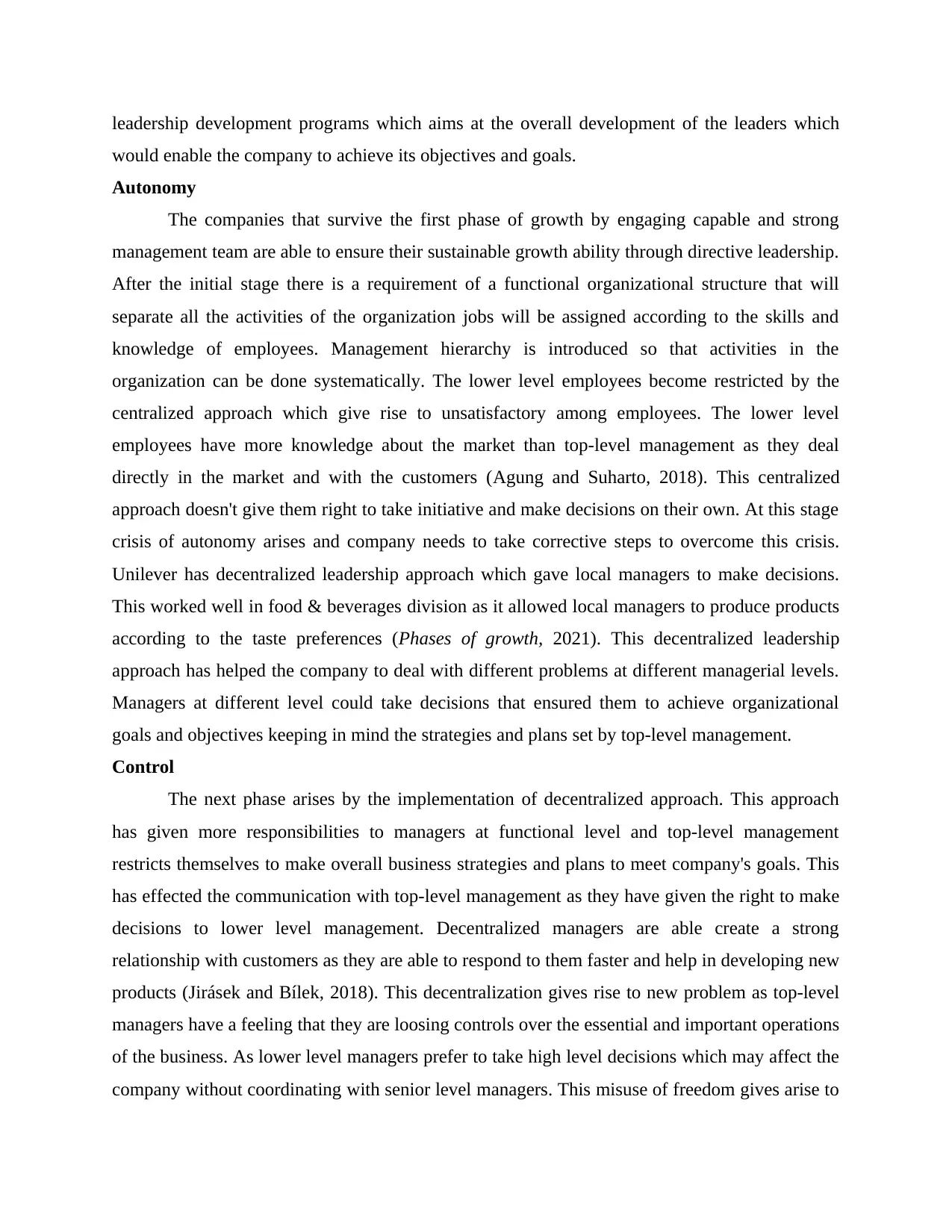
leadership development programs which aims at the overall development of the leaders which
would enable the company to achieve its objectives and goals.
Autonomy
The companies that survive the first phase of growth by engaging capable and strong
management team are able to ensure their sustainable growth ability through directive leadership.
After the initial stage there is a requirement of a functional organizational structure that will
separate all the activities of the organization jobs will be assigned according to the skills and
knowledge of employees. Management hierarchy is introduced so that activities in the
organization can be done systematically. The lower level employees become restricted by the
centralized approach which give rise to unsatisfactory among employees. The lower level
employees have more knowledge about the market than top-level management as they deal
directly in the market and with the customers (Agung and Suharto, 2018). This centralized
approach doesn't give them right to take initiative and make decisions on their own. At this stage
crisis of autonomy arises and company needs to take corrective steps to overcome this crisis.
Unilever has decentralized leadership approach which gave local managers to make decisions.
This worked well in food & beverages division as it allowed local managers to produce products
according to the taste preferences (Phases of growth, 2021). This decentralized leadership
approach has helped the company to deal with different problems at different managerial levels.
Managers at different level could take decisions that ensured them to achieve organizational
goals and objectives keeping in mind the strategies and plans set by top-level management.
Control
The next phase arises by the implementation of decentralized approach. This approach
has given more responsibilities to managers at functional level and top-level management
restricts themselves to make overall business strategies and plans to meet company's goals. This
has effected the communication with top-level management as they have given the right to make
decisions to lower level management. Decentralized managers are able create a strong
relationship with customers as they are able to respond to them faster and help in developing new
products (Jirásek and Bílek, 2018). This decentralization gives rise to new problem as top-level
managers have a feeling that they are loosing controls over the essential and important operations
of the business. As lower level managers prefer to take high level decisions which may affect the
company without coordinating with senior level managers. This misuse of freedom gives arise to
would enable the company to achieve its objectives and goals.
Autonomy
The companies that survive the first phase of growth by engaging capable and strong
management team are able to ensure their sustainable growth ability through directive leadership.
After the initial stage there is a requirement of a functional organizational structure that will
separate all the activities of the organization jobs will be assigned according to the skills and
knowledge of employees. Management hierarchy is introduced so that activities in the
organization can be done systematically. The lower level employees become restricted by the
centralized approach which give rise to unsatisfactory among employees. The lower level
employees have more knowledge about the market than top-level management as they deal
directly in the market and with the customers (Agung and Suharto, 2018). This centralized
approach doesn't give them right to take initiative and make decisions on their own. At this stage
crisis of autonomy arises and company needs to take corrective steps to overcome this crisis.
Unilever has decentralized leadership approach which gave local managers to make decisions.
This worked well in food & beverages division as it allowed local managers to produce products
according to the taste preferences (Phases of growth, 2021). This decentralized leadership
approach has helped the company to deal with different problems at different managerial levels.
Managers at different level could take decisions that ensured them to achieve organizational
goals and objectives keeping in mind the strategies and plans set by top-level management.
Control
The next phase arises by the implementation of decentralized approach. This approach
has given more responsibilities to managers at functional level and top-level management
restricts themselves to make overall business strategies and plans to meet company's goals. This
has effected the communication with top-level management as they have given the right to make
decisions to lower level management. Decentralized managers are able create a strong
relationship with customers as they are able to respond to them faster and help in developing new
products (Jirásek and Bílek, 2018). This decentralization gives rise to new problem as top-level
managers have a feeling that they are loosing controls over the essential and important operations
of the business. As lower level managers prefer to take high level decisions which may affect the
company without coordinating with senior level managers. This misuse of freedom gives arise to
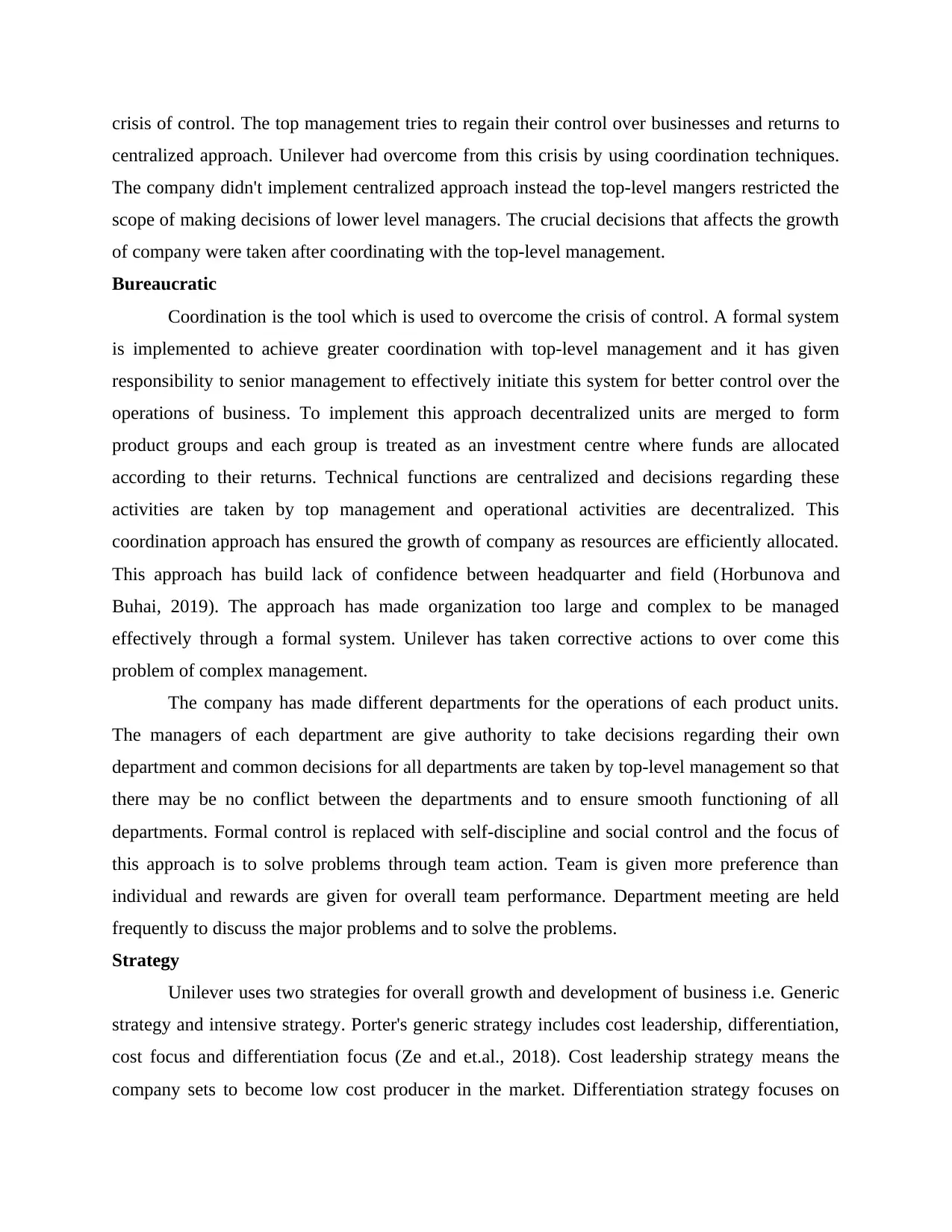
crisis of control. The top management tries to regain their control over businesses and returns to
centralized approach. Unilever had overcome from this crisis by using coordination techniques.
The company didn't implement centralized approach instead the top-level mangers restricted the
scope of making decisions of lower level managers. The crucial decisions that affects the growth
of company were taken after coordinating with the top-level management.
Bureaucratic
Coordination is the tool which is used to overcome the crisis of control. A formal system
is implemented to achieve greater coordination with top-level management and it has given
responsibility to senior management to effectively initiate this system for better control over the
operations of business. To implement this approach decentralized units are merged to form
product groups and each group is treated as an investment centre where funds are allocated
according to their returns. Technical functions are centralized and decisions regarding these
activities are taken by top management and operational activities are decentralized. This
coordination approach has ensured the growth of company as resources are efficiently allocated.
This approach has build lack of confidence between headquarter and field (Horbunova and
Buhai, 2019). The approach has made organization too large and complex to be managed
effectively through a formal system. Unilever has taken corrective actions to over come this
problem of complex management.
The company has made different departments for the operations of each product units.
The managers of each department are give authority to take decisions regarding their own
department and common decisions for all departments are taken by top-level management so that
there may be no conflict between the departments and to ensure smooth functioning of all
departments. Formal control is replaced with self-discipline and social control and the focus of
this approach is to solve problems through team action. Team is given more preference than
individual and rewards are given for overall team performance. Department meeting are held
frequently to discuss the major problems and to solve the problems.
Strategy
Unilever uses two strategies for overall growth and development of business i.e. Generic
strategy and intensive strategy. Porter's generic strategy includes cost leadership, differentiation,
cost focus and differentiation focus (Ze and et.al., 2018). Cost leadership strategy means the
company sets to become low cost producer in the market. Differentiation strategy focuses on
centralized approach. Unilever had overcome from this crisis by using coordination techniques.
The company didn't implement centralized approach instead the top-level mangers restricted the
scope of making decisions of lower level managers. The crucial decisions that affects the growth
of company were taken after coordinating with the top-level management.
Bureaucratic
Coordination is the tool which is used to overcome the crisis of control. A formal system
is implemented to achieve greater coordination with top-level management and it has given
responsibility to senior management to effectively initiate this system for better control over the
operations of business. To implement this approach decentralized units are merged to form
product groups and each group is treated as an investment centre where funds are allocated
according to their returns. Technical functions are centralized and decisions regarding these
activities are taken by top management and operational activities are decentralized. This
coordination approach has ensured the growth of company as resources are efficiently allocated.
This approach has build lack of confidence between headquarter and field (Horbunova and
Buhai, 2019). The approach has made organization too large and complex to be managed
effectively through a formal system. Unilever has taken corrective actions to over come this
problem of complex management.
The company has made different departments for the operations of each product units.
The managers of each department are give authority to take decisions regarding their own
department and common decisions for all departments are taken by top-level management so that
there may be no conflict between the departments and to ensure smooth functioning of all
departments. Formal control is replaced with self-discipline and social control and the focus of
this approach is to solve problems through team action. Team is given more preference than
individual and rewards are given for overall team performance. Department meeting are held
frequently to discuss the major problems and to solve the problems.
Strategy
Unilever uses two strategies for overall growth and development of business i.e. Generic
strategy and intensive strategy. Porter's generic strategy includes cost leadership, differentiation,
cost focus and differentiation focus (Ze and et.al., 2018). Cost leadership strategy means the
company sets to become low cost producer in the market. Differentiation strategy focuses on
⊘ This is a preview!⊘
Do you want full access?
Subscribe today to unlock all pages.

Trusted by 1+ million students worldwide

creating unique featured products and services to attract the customers. Focus strategy includes
cost focus and differentiation focus. Both strategy focuses on niche market by providing low cost
products and unique featured products. Unilever uses differentiation strategy to build competitive
advantage by satisfying the customers with its unique products according to the needs and
preferences of customers (Premec and Guzovski, 2021). The focus of this strategy is to produce
unique featured products that can make company stand against its competitors. For e.g. the
production of dove cream bars which satisfy customers need for soap which is not harsh. The
selling price of the product is relatively high but the company has competitive advantage as
competitors product focuses on cleaning rather than moisturising. This strategy helps Unilever to
increase its revenue which would ultimately offers high growth opportunities.
Unilever also uses intensive strategy for sustainable growth and development of the
company. This Ansoff matrix includes market penetration, market development, product
development and diversification. Market penetration means increasing sales of existing product
in existing market (Korinnyi and Holianchuk, 2018). Market development focuses on selling
existing product in new market. Product development means introduction of new product to
existing market and last diversification means entering into new market with new product. The
primary strategy of Unilever is market penetration in which company focuses on increasing its
revenue by increasing sales volume of existing products. This strategy is successfully
implemented using Generic strategy of differentiation which make its product more competitive
and helps to attract more customers. The success of this strategy is also due to effective and
efficient market strategy of Unilever (Kukartsev and et.al., 2022). The secondary strategy is
product development in which company introduces new products as per the customers' needs
into the existing market which helps it to increase market shares. This intensive strategy has led
company to fulfil strategic objective of continuous product innovations. Such innovation has
helped company to gain competitive advantage in market.
Recommendations
A sustainable business model refers to a model that helps an organization to create value
and deliver it to customers and other stakeholders without affecting nature and socio-culture on
which it relies for smooth functioning of the business. There are four key elements of sustainable
business model i.e. it is commercially profitable, it gives long term success to business, the
cost focus and differentiation focus. Both strategy focuses on niche market by providing low cost
products and unique featured products. Unilever uses differentiation strategy to build competitive
advantage by satisfying the customers with its unique products according to the needs and
preferences of customers (Premec and Guzovski, 2021). The focus of this strategy is to produce
unique featured products that can make company stand against its competitors. For e.g. the
production of dove cream bars which satisfy customers need for soap which is not harsh. The
selling price of the product is relatively high but the company has competitive advantage as
competitors product focuses on cleaning rather than moisturising. This strategy helps Unilever to
increase its revenue which would ultimately offers high growth opportunities.
Unilever also uses intensive strategy for sustainable growth and development of the
company. This Ansoff matrix includes market penetration, market development, product
development and diversification. Market penetration means increasing sales of existing product
in existing market (Korinnyi and Holianchuk, 2018). Market development focuses on selling
existing product in new market. Product development means introduction of new product to
existing market and last diversification means entering into new market with new product. The
primary strategy of Unilever is market penetration in which company focuses on increasing its
revenue by increasing sales volume of existing products. This strategy is successfully
implemented using Generic strategy of differentiation which make its product more competitive
and helps to attract more customers. The success of this strategy is also due to effective and
efficient market strategy of Unilever (Kukartsev and et.al., 2022). The secondary strategy is
product development in which company introduces new products as per the customers' needs
into the existing market which helps it to increase market shares. This intensive strategy has led
company to fulfil strategic objective of continuous product innovations. Such innovation has
helped company to gain competitive advantage in market.
Recommendations
A sustainable business model refers to a model that helps an organization to create value
and deliver it to customers and other stakeholders without affecting nature and socio-culture on
which it relies for smooth functioning of the business. There are four key elements of sustainable
business model i.e. it is commercially profitable, it gives long term success to business, the
Paraphrase This Document
Need a fresh take? Get an instant paraphrase of this document with our AI Paraphraser
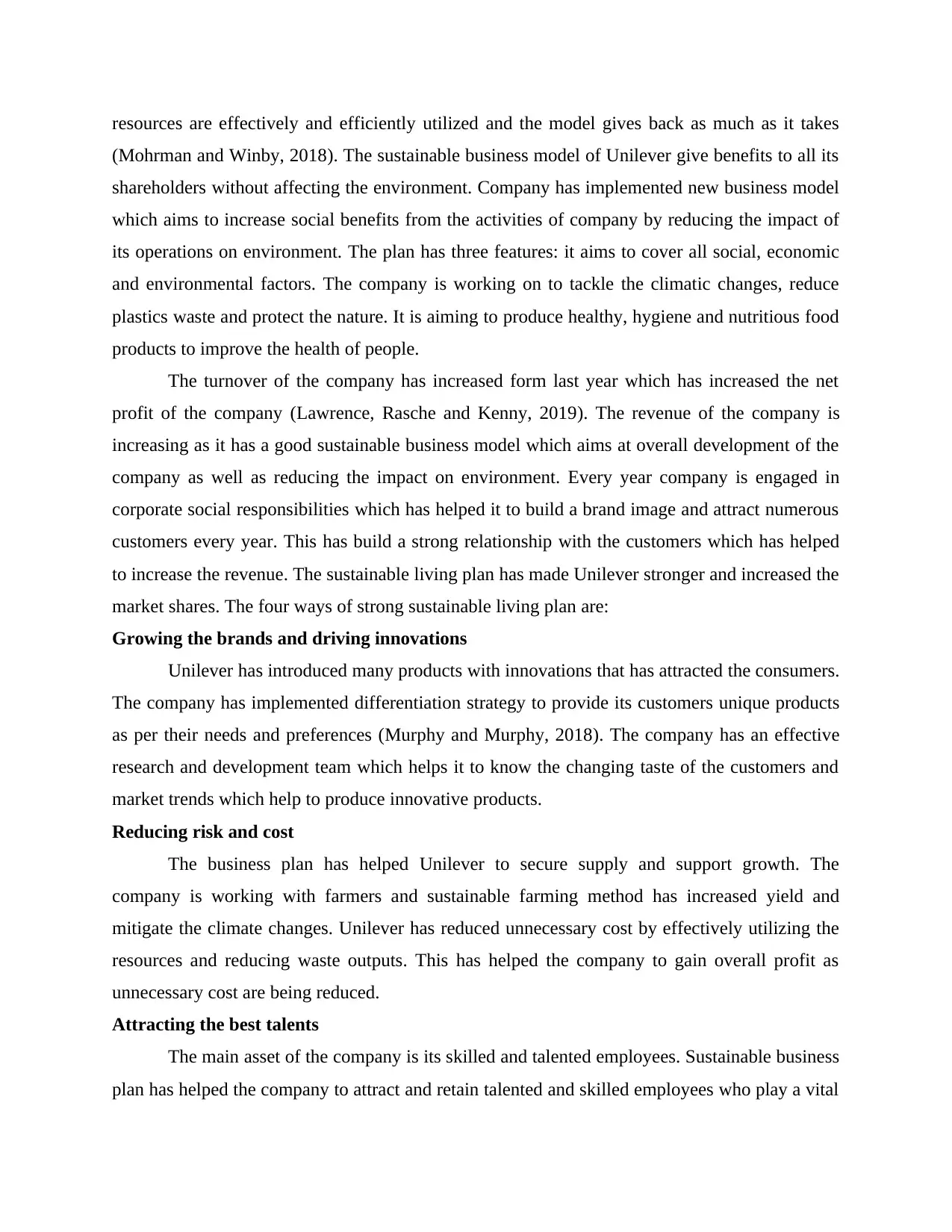
resources are effectively and efficiently utilized and the model gives back as much as it takes
(Mohrman and Winby, 2018). The sustainable business model of Unilever give benefits to all its
shareholders without affecting the environment. Company has implemented new business model
which aims to increase social benefits from the activities of company by reducing the impact of
its operations on environment. The plan has three features: it aims to cover all social, economic
and environmental factors. The company is working on to tackle the climatic changes, reduce
plastics waste and protect the nature. It is aiming to produce healthy, hygiene and nutritious food
products to improve the health of people.
The turnover of the company has increased form last year which has increased the net
profit of the company (Lawrence, Rasche and Kenny, 2019). The revenue of the company is
increasing as it has a good sustainable business model which aims at overall development of the
company as well as reducing the impact on environment. Every year company is engaged in
corporate social responsibilities which has helped it to build a brand image and attract numerous
customers every year. This has build a strong relationship with the customers which has helped
to increase the revenue. The sustainable living plan has made Unilever stronger and increased the
market shares. The four ways of strong sustainable living plan are:
Growing the brands and driving innovations
Unilever has introduced many products with innovations that has attracted the consumers.
The company has implemented differentiation strategy to provide its customers unique products
as per their needs and preferences (Murphy and Murphy, 2018). The company has an effective
research and development team which helps it to know the changing taste of the customers and
market trends which help to produce innovative products.
Reducing risk and cost
The business plan has helped Unilever to secure supply and support growth. The
company is working with farmers and sustainable farming method has increased yield and
mitigate the climate changes. Unilever has reduced unnecessary cost by effectively utilizing the
resources and reducing waste outputs. This has helped the company to gain overall profit as
unnecessary cost are being reduced.
Attracting the best talents
The main asset of the company is its skilled and talented employees. Sustainable business
plan has helped the company to attract and retain talented and skilled employees who play a vital
(Mohrman and Winby, 2018). The sustainable business model of Unilever give benefits to all its
shareholders without affecting the environment. Company has implemented new business model
which aims to increase social benefits from the activities of company by reducing the impact of
its operations on environment. The plan has three features: it aims to cover all social, economic
and environmental factors. The company is working on to tackle the climatic changes, reduce
plastics waste and protect the nature. It is aiming to produce healthy, hygiene and nutritious food
products to improve the health of people.
The turnover of the company has increased form last year which has increased the net
profit of the company (Lawrence, Rasche and Kenny, 2019). The revenue of the company is
increasing as it has a good sustainable business model which aims at overall development of the
company as well as reducing the impact on environment. Every year company is engaged in
corporate social responsibilities which has helped it to build a brand image and attract numerous
customers every year. This has build a strong relationship with the customers which has helped
to increase the revenue. The sustainable living plan has made Unilever stronger and increased the
market shares. The four ways of strong sustainable living plan are:
Growing the brands and driving innovations
Unilever has introduced many products with innovations that has attracted the consumers.
The company has implemented differentiation strategy to provide its customers unique products
as per their needs and preferences (Murphy and Murphy, 2018). The company has an effective
research and development team which helps it to know the changing taste of the customers and
market trends which help to produce innovative products.
Reducing risk and cost
The business plan has helped Unilever to secure supply and support growth. The
company is working with farmers and sustainable farming method has increased yield and
mitigate the climate changes. Unilever has reduced unnecessary cost by effectively utilizing the
resources and reducing waste outputs. This has helped the company to gain overall profit as
unnecessary cost are being reduced.
Attracting the best talents
The main asset of the company is its skilled and talented employees. Sustainable business
plan has helped the company to attract and retain talented and skilled employees who play a vital
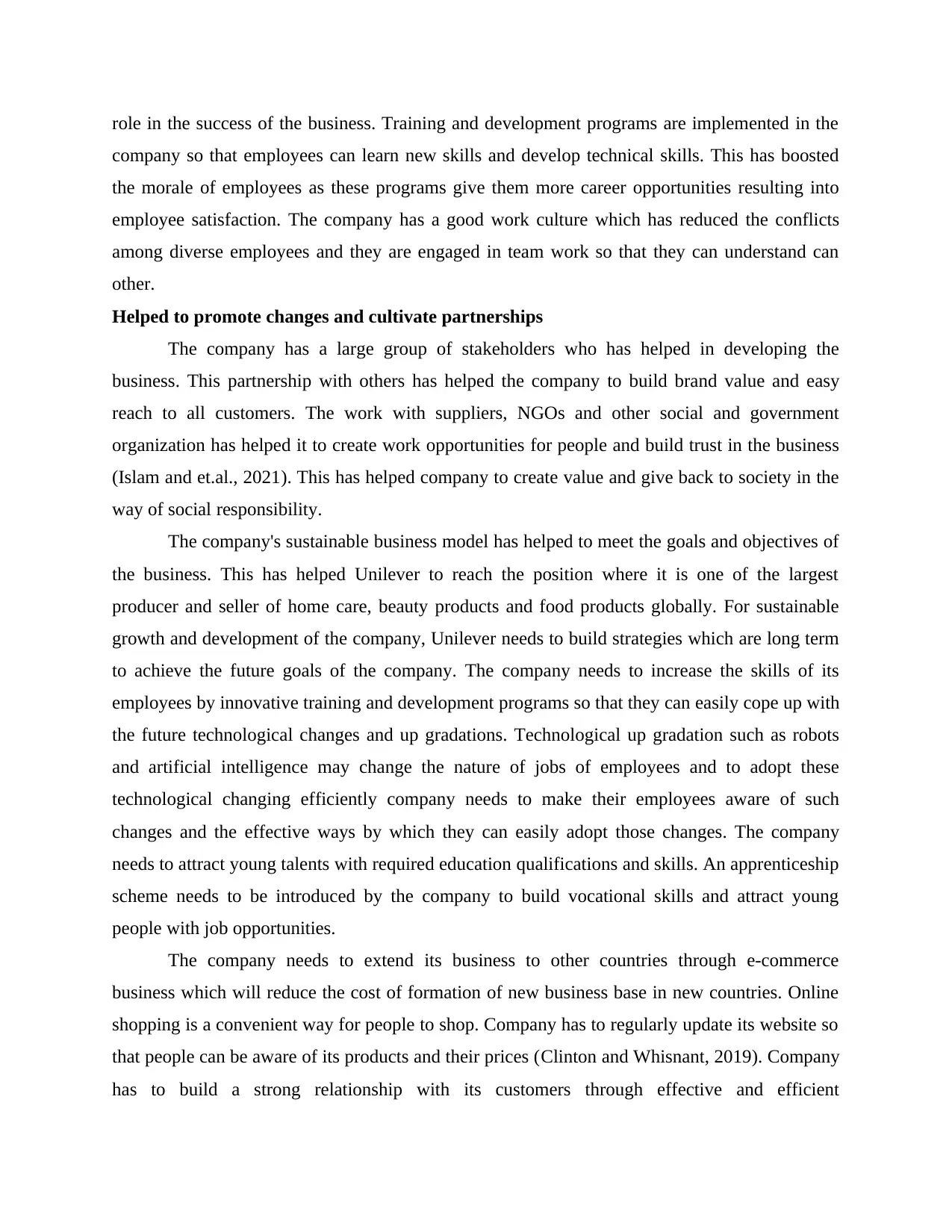
role in the success of the business. Training and development programs are implemented in the
company so that employees can learn new skills and develop technical skills. This has boosted
the morale of employees as these programs give them more career opportunities resulting into
employee satisfaction. The company has a good work culture which has reduced the conflicts
among diverse employees and they are engaged in team work so that they can understand can
other.
Helped to promote changes and cultivate partnerships
The company has a large group of stakeholders who has helped in developing the
business. This partnership with others has helped the company to build brand value and easy
reach to all customers. The work with suppliers, NGOs and other social and government
organization has helped it to create work opportunities for people and build trust in the business
(Islam and et.al., 2021). This has helped company to create value and give back to society in the
way of social responsibility.
The company's sustainable business model has helped to meet the goals and objectives of
the business. This has helped Unilever to reach the position where it is one of the largest
producer and seller of home care, beauty products and food products globally. For sustainable
growth and development of the company, Unilever needs to build strategies which are long term
to achieve the future goals of the company. The company needs to increase the skills of its
employees by innovative training and development programs so that they can easily cope up with
the future technological changes and up gradations. Technological up gradation such as robots
and artificial intelligence may change the nature of jobs of employees and to adopt these
technological changing efficiently company needs to make their employees aware of such
changes and the effective ways by which they can easily adopt those changes. The company
needs to attract young talents with required education qualifications and skills. An apprenticeship
scheme needs to be introduced by the company to build vocational skills and attract young
people with job opportunities.
The company needs to extend its business to other countries through e-commerce
business which will reduce the cost of formation of new business base in new countries. Online
shopping is a convenient way for people to shop. Company has to regularly update its website so
that people can be aware of its products and their prices (Clinton and Whisnant, 2019). Company
has to build a strong relationship with its customers through effective and efficient
company so that employees can learn new skills and develop technical skills. This has boosted
the morale of employees as these programs give them more career opportunities resulting into
employee satisfaction. The company has a good work culture which has reduced the conflicts
among diverse employees and they are engaged in team work so that they can understand can
other.
Helped to promote changes and cultivate partnerships
The company has a large group of stakeholders who has helped in developing the
business. This partnership with others has helped the company to build brand value and easy
reach to all customers. The work with suppliers, NGOs and other social and government
organization has helped it to create work opportunities for people and build trust in the business
(Islam and et.al., 2021). This has helped company to create value and give back to society in the
way of social responsibility.
The company's sustainable business model has helped to meet the goals and objectives of
the business. This has helped Unilever to reach the position where it is one of the largest
producer and seller of home care, beauty products and food products globally. For sustainable
growth and development of the company, Unilever needs to build strategies which are long term
to achieve the future goals of the company. The company needs to increase the skills of its
employees by innovative training and development programs so that they can easily cope up with
the future technological changes and up gradations. Technological up gradation such as robots
and artificial intelligence may change the nature of jobs of employees and to adopt these
technological changing efficiently company needs to make their employees aware of such
changes and the effective ways by which they can easily adopt those changes. The company
needs to attract young talents with required education qualifications and skills. An apprenticeship
scheme needs to be introduced by the company to build vocational skills and attract young
people with job opportunities.
The company needs to extend its business to other countries through e-commerce
business which will reduce the cost of formation of new business base in new countries. Online
shopping is a convenient way for people to shop. Company has to regularly update its website so
that people can be aware of its products and their prices (Clinton and Whisnant, 2019). Company
has to build a strong relationship with its customers through effective and efficient
⊘ This is a preview!⊘
Do you want full access?
Subscribe today to unlock all pages.

Trusted by 1+ million students worldwide
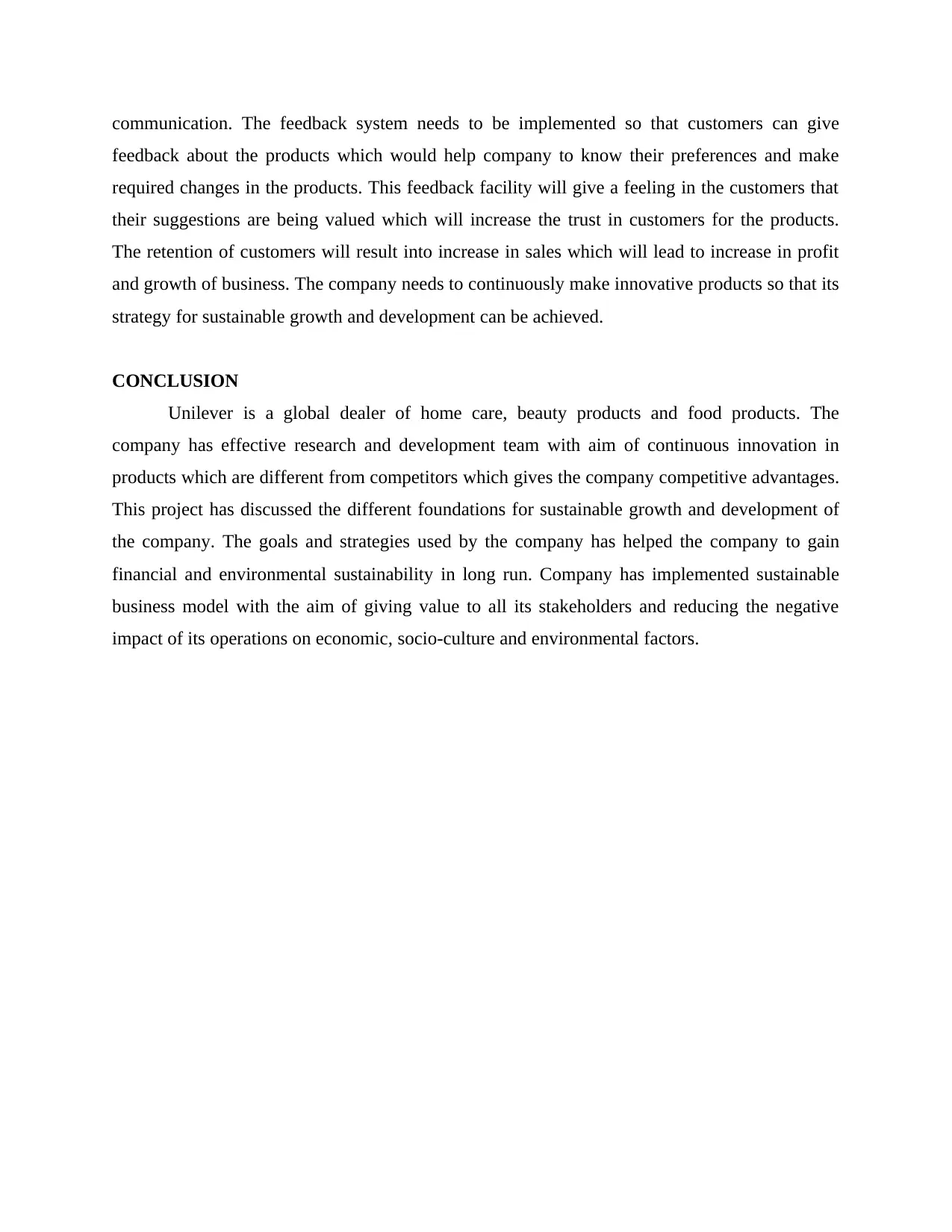
communication. The feedback system needs to be implemented so that customers can give
feedback about the products which would help company to know their preferences and make
required changes in the products. This feedback facility will give a feeling in the customers that
their suggestions are being valued which will increase the trust in customers for the products.
The retention of customers will result into increase in sales which will lead to increase in profit
and growth of business. The company needs to continuously make innovative products so that its
strategy for sustainable growth and development can be achieved.
CONCLUSION
Unilever is a global dealer of home care, beauty products and food products. The
company has effective research and development team with aim of continuous innovation in
products which are different from competitors which gives the company competitive advantages.
This project has discussed the different foundations for sustainable growth and development of
the company. The goals and strategies used by the company has helped the company to gain
financial and environmental sustainability in long run. Company has implemented sustainable
business model with the aim of giving value to all its stakeholders and reducing the negative
impact of its operations on economic, socio-culture and environmental factors.
feedback about the products which would help company to know their preferences and make
required changes in the products. This feedback facility will give a feeling in the customers that
their suggestions are being valued which will increase the trust in customers for the products.
The retention of customers will result into increase in sales which will lead to increase in profit
and growth of business. The company needs to continuously make innovative products so that its
strategy for sustainable growth and development can be achieved.
CONCLUSION
Unilever is a global dealer of home care, beauty products and food products. The
company has effective research and development team with aim of continuous innovation in
products which are different from competitors which gives the company competitive advantages.
This project has discussed the different foundations for sustainable growth and development of
the company. The goals and strategies used by the company has helped the company to gain
financial and environmental sustainability in long run. Company has implemented sustainable
business model with the aim of giving value to all its stakeholders and reducing the negative
impact of its operations on economic, socio-culture and environmental factors.
Paraphrase This Document
Need a fresh take? Get an instant paraphrase of this document with our AI Paraphraser
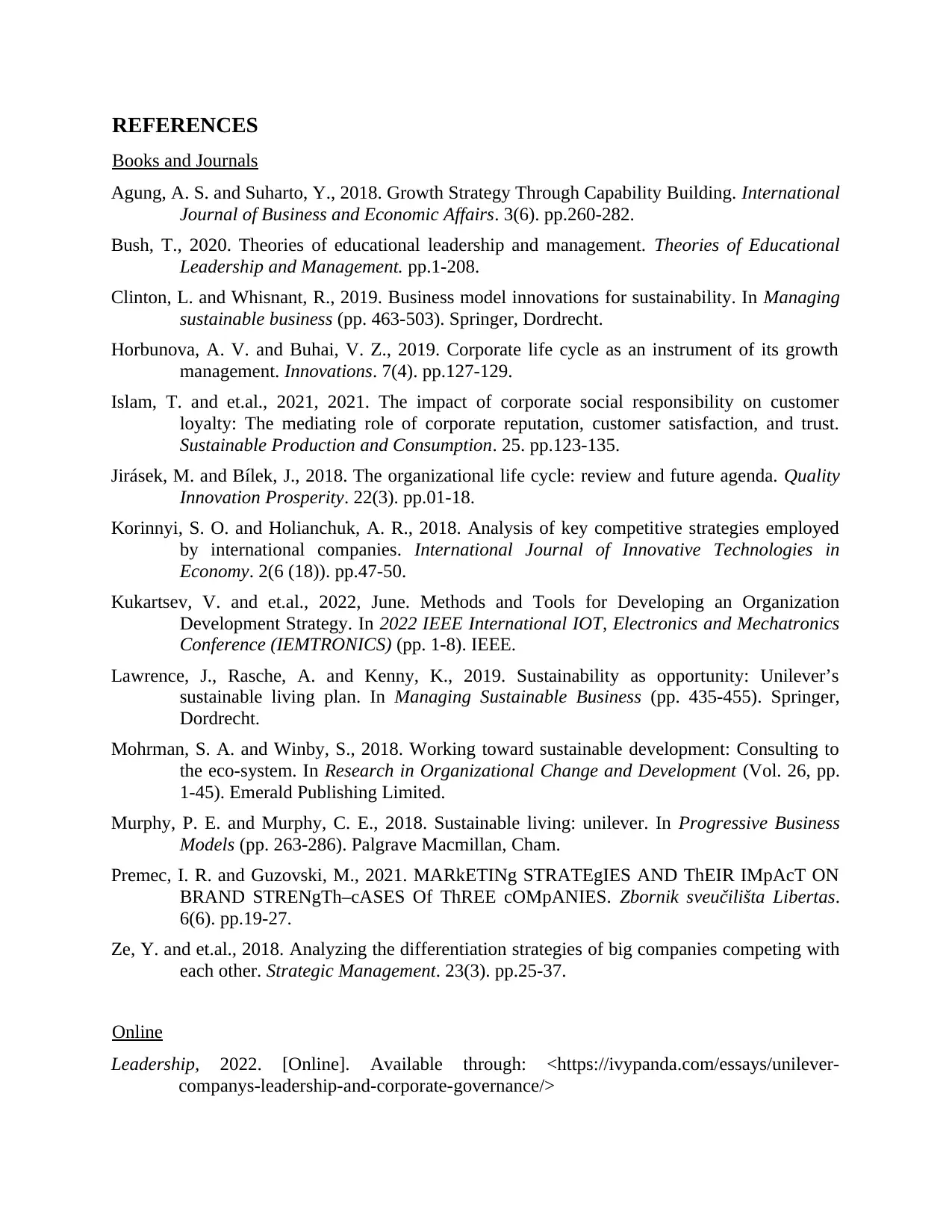
REFERENCES
Books and Journals
Agung, A. S. and Suharto, Y., 2018. Growth Strategy Through Capability Building. International
Journal of Business and Economic Affairs. 3(6). pp.260-282.
Bush, T., 2020. Theories of educational leadership and management. Theories of Educational
Leadership and Management. pp.1-208.
Clinton, L. and Whisnant, R., 2019. Business model innovations for sustainability. In Managing
sustainable business (pp. 463-503). Springer, Dordrecht.
Horbunova, A. V. and Buhai, V. Z., 2019. Corporate life cycle as an instrument of its growth
management. Innovations. 7(4). pp.127-129.
Islam, T. and et.al., 2021, 2021. The impact of corporate social responsibility on customer
loyalty: The mediating role of corporate reputation, customer satisfaction, and trust.
Sustainable Production and Consumption. 25. pp.123-135.
Jirásek, M. and Bílek, J., 2018. The organizational life cycle: review and future agenda. Quality
Innovation Prosperity. 22(3). pp.01-18.
Korinnyi, S. O. and Holianchuk, A. R., 2018. Analysis of key competitive strategies employed
by international companies. International Journal of Innovative Technologies in
Economy. 2(6 (18)). pp.47-50.
Kukartsev, V. and et.al., 2022, June. Methods and Tools for Developing an Organization
Development Strategy. In 2022 IEEE International IOT, Electronics and Mechatronics
Conference (IEMTRONICS) (pp. 1-8). IEEE.
Lawrence, J., Rasche, A. and Kenny, K., 2019. Sustainability as opportunity: Unilever’s
sustainable living plan. In Managing Sustainable Business (pp. 435-455). Springer,
Dordrecht.
Mohrman, S. A. and Winby, S., 2018. Working toward sustainable development: Consulting to
the eco-system. In Research in Organizational Change and Development (Vol. 26, pp.
1-45). Emerald Publishing Limited.
Murphy, P. E. and Murphy, C. E., 2018. Sustainable living: unilever. In Progressive Business
Models (pp. 263-286). Palgrave Macmillan, Cham.
Premec, I. R. and Guzovski, M., 2021. MARkETINg STRATEgIES AND ThEIR IMpAcT ON
BRAND STRENgTh–cASES Of ThREE cOMpANIES. Zbornik sveučilišta Libertas.
6(6). pp.19-27.
Ze, Y. and et.al., 2018. Analyzing the differentiation strategies of big companies competing with
each other. Strategic Management. 23(3). pp.25-37.
Online
Leadership, 2022. [Online]. Available through: <https://ivypanda.com/essays/unilever-
companys-leadership-and-corporate-governance/>
Books and Journals
Agung, A. S. and Suharto, Y., 2018. Growth Strategy Through Capability Building. International
Journal of Business and Economic Affairs. 3(6). pp.260-282.
Bush, T., 2020. Theories of educational leadership and management. Theories of Educational
Leadership and Management. pp.1-208.
Clinton, L. and Whisnant, R., 2019. Business model innovations for sustainability. In Managing
sustainable business (pp. 463-503). Springer, Dordrecht.
Horbunova, A. V. and Buhai, V. Z., 2019. Corporate life cycle as an instrument of its growth
management. Innovations. 7(4). pp.127-129.
Islam, T. and et.al., 2021, 2021. The impact of corporate social responsibility on customer
loyalty: The mediating role of corporate reputation, customer satisfaction, and trust.
Sustainable Production and Consumption. 25. pp.123-135.
Jirásek, M. and Bílek, J., 2018. The organizational life cycle: review and future agenda. Quality
Innovation Prosperity. 22(3). pp.01-18.
Korinnyi, S. O. and Holianchuk, A. R., 2018. Analysis of key competitive strategies employed
by international companies. International Journal of Innovative Technologies in
Economy. 2(6 (18)). pp.47-50.
Kukartsev, V. and et.al., 2022, June. Methods and Tools for Developing an Organization
Development Strategy. In 2022 IEEE International IOT, Electronics and Mechatronics
Conference (IEMTRONICS) (pp. 1-8). IEEE.
Lawrence, J., Rasche, A. and Kenny, K., 2019. Sustainability as opportunity: Unilever’s
sustainable living plan. In Managing Sustainable Business (pp. 435-455). Springer,
Dordrecht.
Mohrman, S. A. and Winby, S., 2018. Working toward sustainable development: Consulting to
the eco-system. In Research in Organizational Change and Development (Vol. 26, pp.
1-45). Emerald Publishing Limited.
Murphy, P. E. and Murphy, C. E., 2018. Sustainable living: unilever. In Progressive Business
Models (pp. 263-286). Palgrave Macmillan, Cham.
Premec, I. R. and Guzovski, M., 2021. MARkETINg STRATEgIES AND ThEIR IMpAcT ON
BRAND STRENgTh–cASES Of ThREE cOMpANIES. Zbornik sveučilišta Libertas.
6(6). pp.19-27.
Ze, Y. and et.al., 2018. Analyzing the differentiation strategies of big companies competing with
each other. Strategic Management. 23(3). pp.25-37.
Online
Leadership, 2022. [Online]. Available through: <https://ivypanda.com/essays/unilever-
companys-leadership-and-corporate-governance/>
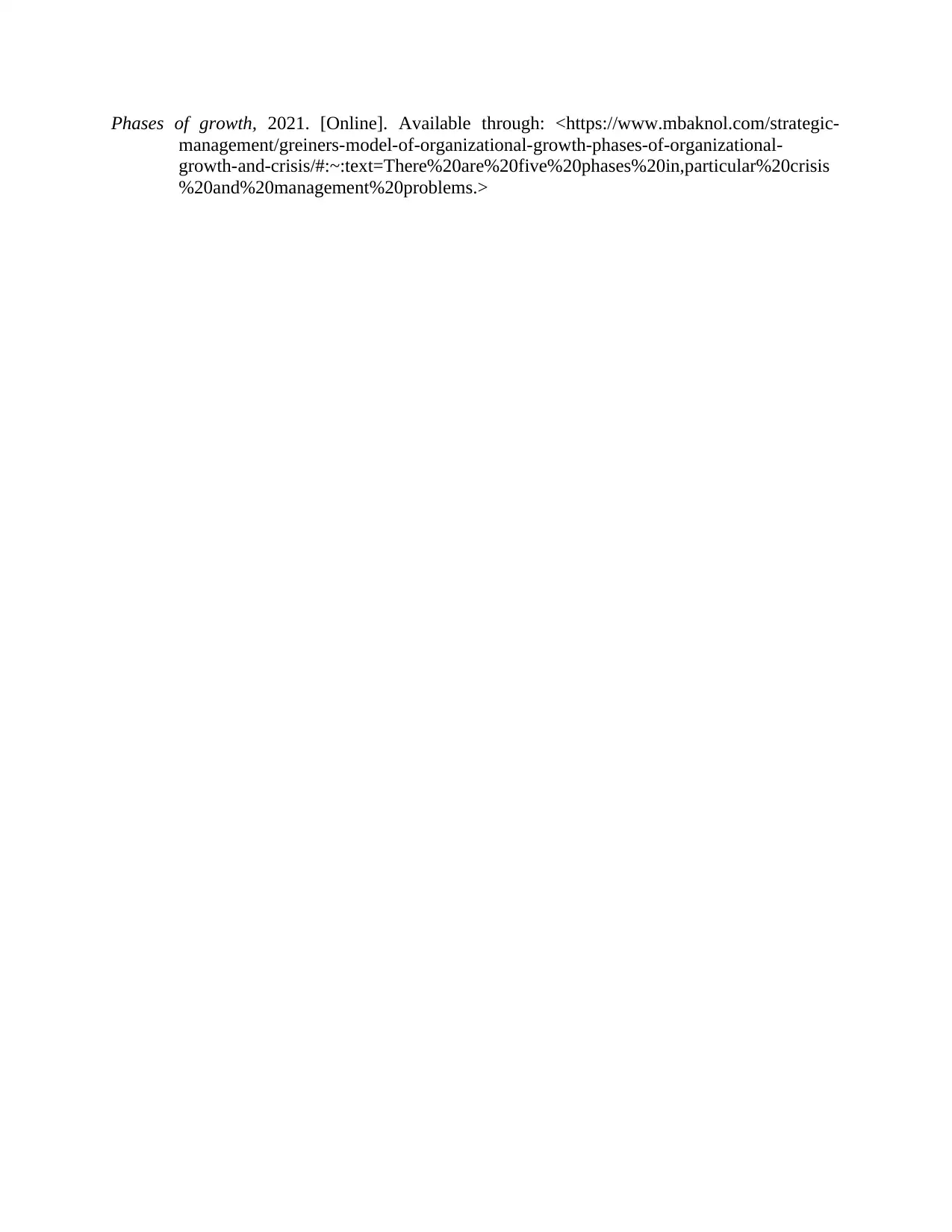
Phases of growth, 2021. [Online]. Available through: <https://www.mbaknol.com/strategic-
management/greiners-model-of-organizational-growth-phases-of-organizational-
growth-and-crisis/#:~:text=There%20are%20five%20phases%20in,particular%20crisis
%20and%20management%20problems.>
management/greiners-model-of-organizational-growth-phases-of-organizational-
growth-and-crisis/#:~:text=There%20are%20five%20phases%20in,particular%20crisis
%20and%20management%20problems.>
⊘ This is a preview!⊘
Do you want full access?
Subscribe today to unlock all pages.

Trusted by 1+ million students worldwide
1 out of 12
Related Documents
Your All-in-One AI-Powered Toolkit for Academic Success.
+13062052269
info@desklib.com
Available 24*7 on WhatsApp / Email
![[object Object]](/_next/static/media/star-bottom.7253800d.svg)
Unlock your academic potential
Copyright © 2020–2025 A2Z Services. All Rights Reserved. Developed and managed by ZUCOL.





